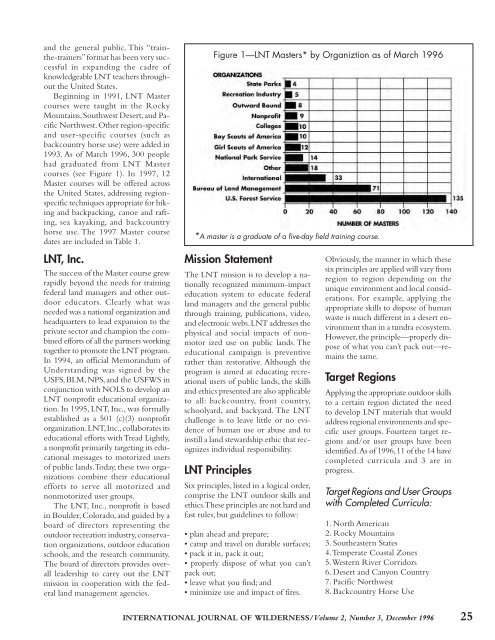P3-Vol 2.No3 Dec 96 - International Journal of Wilderness
P3-Vol 2.No3 Dec 96 - International Journal of Wilderness
P3-Vol 2.No3 Dec 96 - International Journal of Wilderness
You also want an ePaper? Increase the reach of your titles
YUMPU automatically turns print PDFs into web optimized ePapers that Google loves.
and the general public. This “trainthe-trainers”<br />
format has been very successful<br />
in expanding the cadre <strong>of</strong><br />
knowledgeable LNT teachers throughout<br />
the United States.<br />
Beginning in 1991, LNT Master<br />
courses were taught in the Rocky<br />
Mountains, Southwest Desert, and Pacific<br />
Northwest. Other region-specific<br />
and user-specific courses (such as<br />
backcountry horse use) were added in<br />
1993. As <strong>of</strong> March 19<strong>96</strong>, 300 people<br />
had graduated from LNT Master<br />
courses (see Figure 1). In 1997, 12<br />
Master courses will be <strong>of</strong>fered across<br />
the United States, addressing regionspecific<br />
techniques appropriate for hiking<br />
and backpacking, canoe and rafting,<br />
sea kayaking, and backcountry<br />
horse use. The 1997 Master course<br />
dates are included in Table 1.<br />
LNT, Inc.<br />
The success <strong>of</strong> the Master course grew<br />
rapidly beyond the needs for training<br />
federal land managers and other outdoor<br />
educators. Clearly what was<br />
needed was a national organization and<br />
headquarters to lead expansion to the<br />
private sector and champion the combined<br />
efforts <strong>of</strong> all the partners working<br />
together to promote the LNT program.<br />
In 1994, an <strong>of</strong>ficial Memorandum <strong>of</strong><br />
Understanding was signed by the<br />
USFS, BLM, NPS, and the USFWS in<br />
conjunction with NOLS to develop an<br />
LNT nonpr<strong>of</strong>it educational organization.<br />
In 1995, LNT, Inc., was formally<br />
established as a 501 (c)(3) nonpr<strong>of</strong>it<br />
organization. LNT, Inc., collaborates its<br />
educational efforts with Tread Lightly,<br />
a nonpr<strong>of</strong>it primarily targeting its educational<br />
messages to motorized users<br />
<strong>of</strong> public lands. Today, these two organizations<br />
combine their educational<br />
efforts to serve all motorized and<br />
nonmotorized user groups.<br />
The LNT, Inc., nonpr<strong>of</strong>it is based<br />
in Boulder, Colorado, and guided by a<br />
board <strong>of</strong> directors representing the<br />
outdoor recreation industry, conservation<br />
organizations, outdoor education<br />
schools, and the research community.<br />
The board <strong>of</strong> directors provides overall<br />
leadership to carry out the LNT<br />
mission in cooperation with the federal<br />
land management agencies.<br />
Figure 1—LNT Masters* by Organiztion as <strong>of</strong> March 19<strong>96</strong><br />
*A master is a graduate <strong>of</strong> a five-day field training course.<br />
Mission Statement<br />
The LNT mission is to develop a nationally<br />
recognized minimum-impact<br />
education system to educate federal<br />
land managers and the general public<br />
through training, publications, video,<br />
and electronic webs. LNT addresses the<br />
physical and social impacts <strong>of</strong> nonmotor<br />
ized use on public lands. The<br />
educational campaign is preventive<br />
rather than restorative. Although the<br />
program is aimed at educating recreational<br />
users <strong>of</strong> public lands, the skills<br />
and ethics presented are also applicable<br />
to all: backcountry, front country,<br />
schoolyard, and backyard. The LNT<br />
challenge is to leave little or no evidence<br />
<strong>of</strong> human use or abuse and to<br />
instill a land stewardship ethic that recognizes<br />
individual responsibility.<br />
LNT Principles<br />
Six principles, listed in a logical order,<br />
comprise the LNT outdoor skills and<br />
ethics. These principles are not hard and<br />
fast rules, but guidelines to follow:<br />
• plan ahead and prepare;<br />
• camp and travel on durable surfaces;<br />
• pack it in, pack it out;<br />
• properly dispose <strong>of</strong> what you can’t<br />
pack out;<br />
• leave what you find; and<br />
• minimize use and impact <strong>of</strong> fires.<br />
Obviously, the manner in which these<br />
six principles are applied will vary from<br />
region to region depending on the<br />
unique environment and local considerations.<br />
For example, applying the<br />
appropriate skills to dispose <strong>of</strong> human<br />
waste is much different in a desert environment<br />
than in a tundra ecosystem.<br />
However, the principle—properly dispose<br />
<strong>of</strong> what you can’t pack out—remains<br />
the same.<br />
Target Regions<br />
Applying the appropriate outdoor skills<br />
to a certain region dictated the need<br />
to develop LNT materials that would<br />
address regional environments and specific<br />
user groups. Fourteen target regions<br />
and/or user groups have been<br />
identified. As <strong>of</strong> 19<strong>96</strong>, 11 <strong>of</strong> the 14 have<br />
completed curricula and 3 are in<br />
progress.<br />
Target Regions and User Groups<br />
with Completed Curricula:<br />
1. North American<br />
2. Rocky Mountains<br />
3. Southeastern States<br />
4. Temperate Coastal Zones<br />
5. Western River Corridors<br />
6. Desert and Canyon Country<br />
7. Pacific Northwest<br />
8. Backcountry Horse Use<br />
INTERNATIONAL JOURNAL OF WILDERNESS/<strong>Vol</strong>ume 2, Number 3, <strong>Dec</strong>ember 19<strong>96</strong> 25










